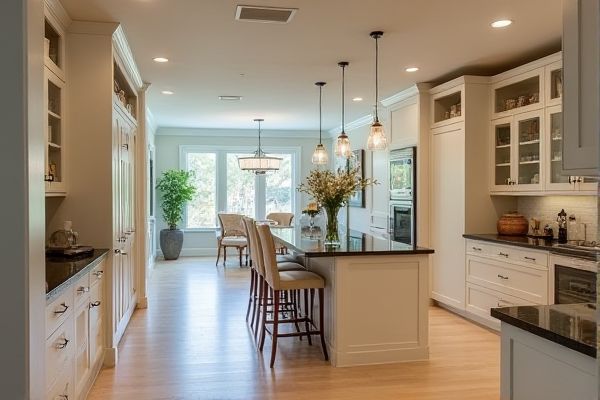
A walk-in pantry offers ample storage space with easy access to everyday kitchen items, whereas a butler's pantry serves as a transitional area for meal prep, staging, and entertaining guests. Discover which pantry style best enhances your kitchen's functionality by reading the rest of the article.
Table of Comparison
| Feature | Walk-In Pantry | Butler's Pantry |
|---|---|---|
| Purpose | Storage for dry goods, bulk items, and kitchen essentials | Prep area and additional storage, often for serving and staging meals |
| Location | Adjacent to the kitchen | Between kitchen and dining room |
| Size | Large enough for walk-in access | Smaller, designed for workspace and storage |
| Features | Shelves for food storage, sometimes refrigeration | Countertops, sink, cabinetry, wine storage |
| Use Case | Organizing groceries and household food supplies | Food prep, plating, entertaining guests |
| Design Focus | Maximizing storage efficiency | Enhancing kitchen flow and serving functionality |
Understanding Walk-In Pantries
A walk-in pantry provides ample storage space with shelves and cabinets that allow you to organize bulk food items, kitchen supplies, and small appliances efficiently. Unlike a butler's pantry, which often serves as a transitional area for meal preparation and serving, a walk-in pantry is primarily designed for maximizing storage capacity and ease of access. Your home benefits from a walk-in pantry by creating a clutter-free kitchen and keeping essentials neatly stored within reach.
What Is a Butler’s Pantry?
A butler's pantry is a small, transitional space between the kitchen and dining area designed for storing serving ware, preparing meals, and staging dishes for formal entertaining. It typically features cabinetry, countertop space, and sometimes a sink or wine fridge to facilitate efficient food and drink service. Unlike a walk-in pantry, which primarily focuses on food storage, a butler's pantry enhances kitchen workflow and simplifies hosting by providing a dedicated area for meal prep and cleanup.
Key Differences Between Walk-In and Butler’s Pantries
A walk-in pantry offers ample storage space with easy access for bulk items, making it ideal for organizing your groceries and kitchen essentials. A butler's pantry, designed as a transitional area between the kitchen and dining room, often includes countertops and cabinetry for food preparation and serving. Choosing between the two depends on your kitchen layout and whether you prioritize storage capacity or a functional staging area for entertaining.
Space and Storage Considerations
A walk-in pantry offers expansive space with deep shelves and multiple storage zones, ideal for bulk food items and large kitchen tools, maximizing your kitchen's overall organization. A butler's pantry, while more compact, emphasizes efficient storage for serving ware, glassware, and small appliances, integrating seamlessly between the kitchen and dining areas. Your choice depends on whether you prioritize extensive storage capacity or a convenient staging area for entertaining and meal preparation.
Design and Aesthetic Appeal
A walk-in pantry offers a spacious, open design often featuring adjustable shelving and clear storage containers for a minimalist, organized look that enhances kitchen efficiency. In contrast, a butler's pantry combines functionality with elegance, typically showcasing custom cabinetry, countertop space, and upscale finishes like marble or glass to create a refined transition area between the kitchen and dining room. Both pantries boost aesthetic appeal by integrating tailored storage solutions that complement the overall kitchen style while reflecting distinct design intentions.
Functionality and Use Cases
Walk-in pantries offer extensive storage space ideal for bulk groceries, kitchen appliances, and food prep organization, making them perfect for families who cook frequently or entertain often. Butler's pantries serve as staging areas between kitchens and dining rooms, designed for serving, plating, and storing serving ware, optimizing meal presentation and entertaining efficiency. Your choice depends on whether you prioritize large-scale food storage (walk-in pantry) or streamlined meal service and entertaining support (butler's pantry).
Cost Comparison: Walk-In vs Butler’s Pantry
A walk-in pantry typically costs between $2,000 and $5,000, depending on size and materials, while a butler's pantry ranges from $5,000 to $15,000 due to added cabinetry, countertops, and appliances. Walk-in pantries offer a more budget-friendly storage solution focused on space and organization, whereas butler's pantries serve as a functional staging area for serving and entertaining, increasing overall project costs. Choosing between the two depends on kitchen layout needs and budget priorities, with butler's pantries demanding higher investment for luxury features.
Organization and Accessibility
A walk-in pantry offers ample storage with open shelving and clear visibility, making organization straightforward and items easily accessible for everyday use. In contrast, a butler's pantry often includes cabinetry and countertop space, providing organized storage with a more refined setup ideal for staging meals and serving guests. Both pantries enhance kitchen efficiency, but the walk-in pantry prioritizes convenience while the butler's pantry emphasizes elegant accessibility.
Pros and Cons of Walk-In Pantries
Walk-in pantries offer ample storage space, making it easier to organize bulk items, small appliances, and pantry essentials, which helps streamline your kitchen workflow. They tend to be more spacious than butler's pantries but require a dedicated area that might not be feasible in smaller homes. While walk-in pantries provide excellent accessibility and visibility, their size can sometimes lead to clutter if not properly maintained.
Pros and Cons of Butler’s Pantries
Butler's pantries offer elegant storage and prep space, enhancing kitchen organization and entertaining flow, with features like cabinetry, countertops, and sometimes a sink. Their primary drawback is the higher cost and space requirement compared to walk-in pantries, making them less practical for smaller homes. However, butler's pantries provide a sophisticated buffer between kitchen and dining areas, ideal for staging meals and concealing clutter during gatherings.
 homyna.com
homyna.com